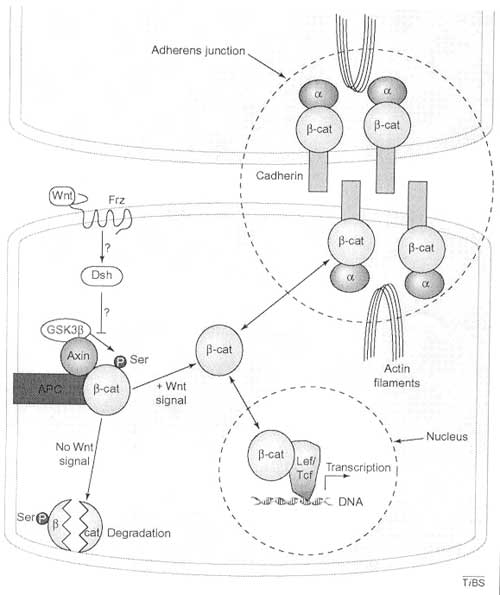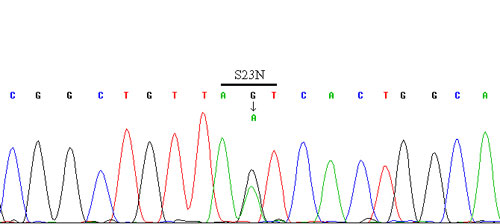The gene coding β-catenin is located on the chromosome 3 in the region p22-p21. β-catenin is a multifunctional protein which is involved in Ca2+-dependent intercellular adhesion, regulation of gene expression through its influence in Wnt/Wingless signaling pathway and some other cell processes.
β-catenin in adhesive joints interact with a cytoplasmatic part of transmembrane cadherins on the one side and with α-cateninem, which binds acting filaments, on the other side. This is the way to ensure the stability of these joints (Fig. 1). The loss or disrupting of β-catenin then cause a violation of normal adhesive cell adhesion.
The second essential function of β-catenin, except for intercellular interactions, is its influence as a transcriptional cofactor in the Wnt/Wingless signaling pathway. This system is, in the case of growth factor Wnt absence, negatively regulated using a protein complex APC-Axin-GSK3β (Adenomatous polyposis coli-Axin-Glykogen synthase kinase 3β), which phosphorylates β-catenin at serine and threonine on the N terminal end and thus it allows its Ubiquitin-mediated degradation. When the Wnt signal is present, GSK3β is inhibited, there is no β-catenin degradation and it interacts with the transcription factors from Tcf/Lef family. It activates, inter alia, the genes participating on cell proliferation, such as Cyclin D1 etc. (Fig. 1). A similar situation occurs also when any of the proteins involved in the regulation of Wnt/Wingless signaling pathway is damaged, in particular the APC and the gene for β-catenin, that are mutated in a wide range of tumor diseases.
The β-catenin gene was analyzed in our study for the presence of the mutations in exon 3 which contains the sites for a phosphorylation of GSK3β. A patient was investigated with a rare pigmented solid and pseudopapillary pancreatic tumor.
Examination
In our laboratory we perform the examination of exon 3 of the gene CTNNB1 using direct sequencing.
Analytical sensitivity and specificity of the sequencing: 99%.
Limitations:
In the case of the analysis of somatic mutations by sequencing the mutations will not be detected, if the altered cell line is not represented by at least 20%.
Literatura
- Koch A, Denkhaus D, Albrecht S, Leuschner I, von Schweinitz D, Pietsch T. Childhood hepatoblastomas frequently carry a mutated degradation targeting box of the beta-catenin gene. Cancer Res. 1999;59(2):269-73.
- Akiyama T. Wnt/beta-catenin signaling. Cytokine Growth Factor Rev. 2000;11(4):273-82.
- Daniels DL, Eklof Spink K, Weis WI. β-catenin: molecular plasticity and drug design. Trends Biochem Sci. 2001;26(11):672-8.
- Abraham SC, Klimstra DS, Wilentz RE, et al. Solid-pseudopapillary tumors of the pancreas are genetically distinct from pancreatic ductal adenocarcinomas and almost always harbor β-catenin mutations. Am J Pathol 2002;160:1361-1369.




